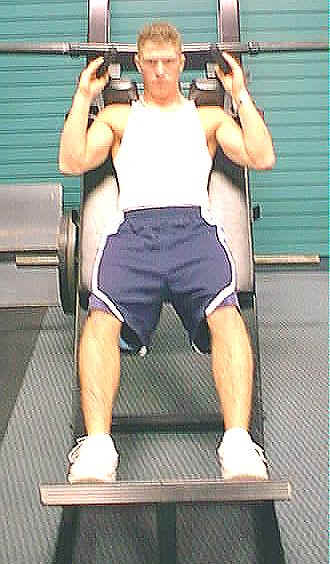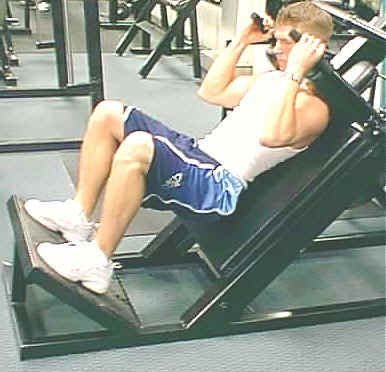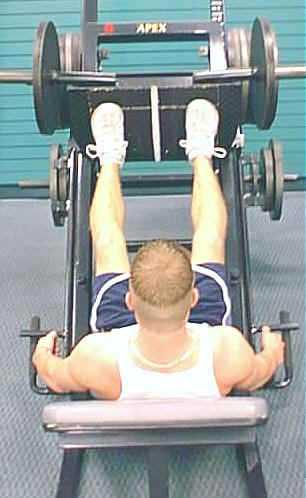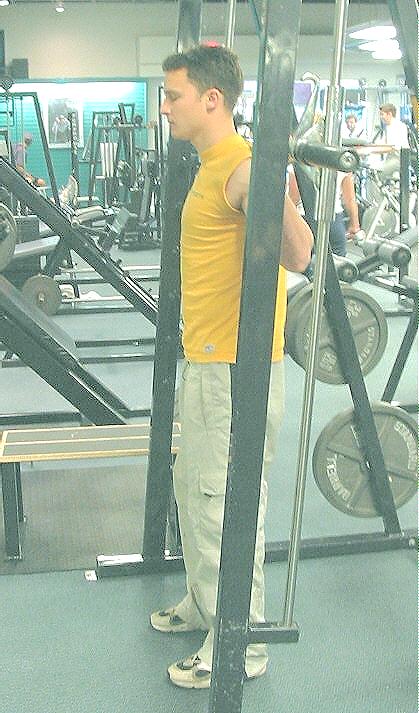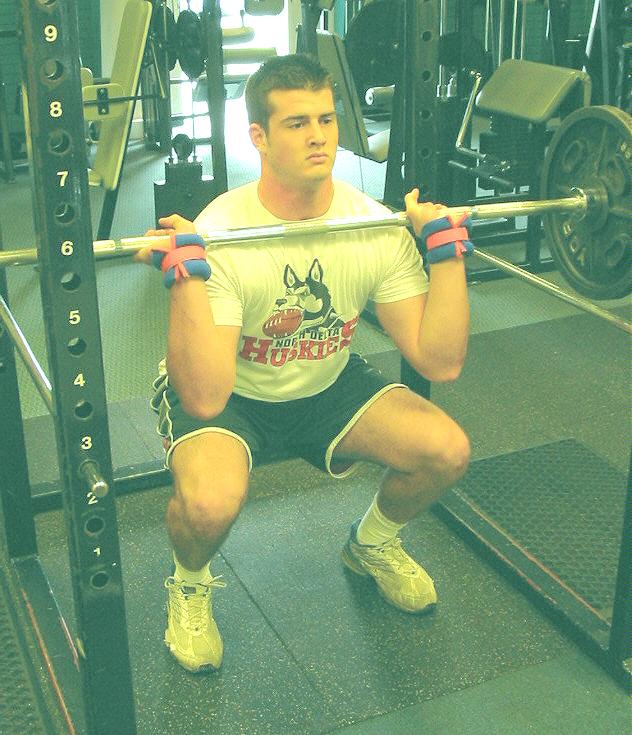|
Leg Training: Foundation / Sport Specific Strength Training Exercises Two Leg Exercises for base strength or sport specificity (entry or maintenance skating skills) |
||||
| It is important to warm-up with light weights for a couple of sets using higher reps. I believe in using 30 reps for the first warm up set, 20 for the second, and then set of 10 thereafter until I reach my training weight unless performing high reps sets of 40% (30-40 reps) of 1 RM. This is a muscle specific warm-up. | ||||
| No. | Exercise | Picture: Start | Picture: Finish | Basic Description |
| 1A | Hack Squats |
|
|
Narrow Foot Position Lower training weight (approx 1 sec.on descent) then hold bottom position and explode upwards. Breathe in when lowering, out when extending. Keep abs tight. Depending on training width (6" to 16"), keep knees aligned over toes. |
| 1B |
|
|
Wide Foot Position Lower weight (approx 1 sec. on descent) then hold bottom position and explode upwards. Breathe in when lowering, out when extending. Keep abs tight and lower back against pad. Depending on training width (6" to 16"), keep knees aligned over toes on descent. |
|
| 2 | Hack Squats |
|
|
Wide position shown (gliding position)
Drop into position (free fall), thighs parallel to foot platform, hold for 3 to 5 seconds. explode upwards. Repeat drop and hold, then extension. Alternate training would be to drop, hold, and then perform full reps (up, down, up, down, up, down - drop and hold and then repeat). |
| 3A | Inverted Leg Press |
|
|
Narrow Position
Lower training weight (approx 1 sec. on descent) then hold bottom position and explode upwards. Breathe in when lowering, out when extending. Keep abs tight. Depending on training width (6" to 16"), keep knees aligned over toes. |
| 3B |
|
|
Wide Position
Lower training weight (approx 1 sec. on descent) then hold bottom position and explode upwards. Breathe in when lowering, out when extending. Keep abs tight. Depending on training width (6" to 16"), keep knees aligned over toes. |
|
| 4 | Inverted Press 2 |
|
|
Wide position shown
Drop foot platform into position (free fall), thighs parallel to foot platform, catch and hold for 3 to 5 seconds. explode upwards. Repeat drop and hold, then extension. Alternate training would be to drop, hold, and then perform full reps (up, down, up, down, up, down - drop and hold and then repeat). |
| 5 | Smith Squat |
|
||
|
The above exercise is the one that I prefer as a substitute for the Squat. While hard-core lifters rally around the squat, young lifters have problems learning the movement correctly and due to the load on the lower back and gluts (butt) serious injury can occur. There are two main problems with learning the squat for beginners: 1 - is that their Gluts are more developed than their thigh muscles. In order to train correctly a parallel thigh-to-floor position should be used and this taxes the lower quads. When tiring, athletes tend to learn forward which, again, stresses the lower back. The second (2) - Is balancing the lift when training with heavier weights and maintaining discipline when doing so. I suffered a strain of one of my facet joints of my lower back performing the squat with heavy weights. To this day it still bothers me. I avoid this exercise at all cost and while this exercise has a tremendous effect on the body, the risk of injury can be substituted by the SMITH Machine. The action of the hips, torso, etc is a MUST learn with light weights. And, although not shown above, a weight belt should be mandatory. Again, hard core lifters say that this weakens the lower back. I feel that there are enough exercises to strengthen the lower back without risking injury. A very famous body builder by the name of Fred Hatfield (better known as Doctor Squat), stresses adamantly that squatting demands the use of a weight belt and that failure to do so WILL ultimately result in a lower back injury. The advantage of the Smith Machine Squat is that one can perform a wide variety of variations that target the inner, middle and outer thighs as well as targeting either the gluts or the area of the lower thigh. Position the bar across the shoulders as shown with the feet slightly wider than shoulder width apart (depending on training requirement). Lower weight breathing inwards as you go down, holding breathe at bottom of lift and then driving upwards. Keep head erect. |
||||
| 6 | Front Squat |
|
||
|
The above exercise is another trade off where free weights are to be used. The advantage of having the bar in front of the body is that it limits the stress placed on the lower back as well as targets the area of the lower thigh so important for hockey players. The main problem is feeling comfortable handling the weight this way. Some athletes place the bar on their shoulders and cross their arms to hold the bar in place (finger tips to opposite shoulder) or as in this pic. keep the elbows under the bar and wrists outwards. Perform the same way as in the Smith Squat. |
||||
| Single Leg Exercises (inside, front of thighs - origin of skating stride) | ||||
| 1 | Single Leg Press |
|
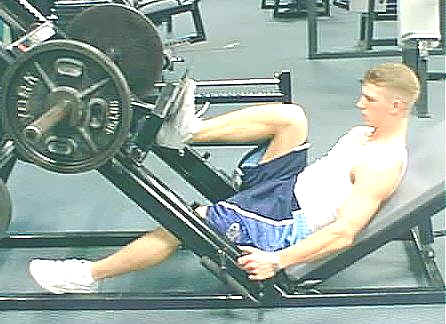 |
Single Leg Press utilizing the Inverted Leg Press Machine. The advantage of this exercise is that the lower back is stabilized and the athlete can concentrate on knee alignment and muscle isolation. Variations can include: press, hold and press, drop/hold and press. |
| 2 | Smith Machine Lunges |
|
|
Find foot position under bar. As shown, the load placed is more on the lower thigh. Position the foot so that at the bottom of the lift, your heel does not come off of the floor (this will depend on your ankle flexibility). If this does happen and you want a lower position, place a weight plate under your heel. Inhale when lowering weight and outward when raising. |
| 3 | DB Lunges |
|
||
|
Lunges can be performed several different ways: 1 - step, lower, press up and return to standing position as shown above or as in the middle two pics. (and in the Smith lunge) keep feet spaced, lower and raise, repeat. or 3 - The walking lunge stepping forwards alternating stepping, lower and raise, step, lower and raise, etc. Two (2) is the most basic, first finding the proper foot gap and then lowering and raising the weight. Breathe in when lowering weight and exhale when standing. |
||||
| 4 | One Leg Squat |  |
 |
This is an advanced lunge requiring a certain degree of balance and proficiency Find a box or in this case a low bench approx. knee height. Find the proper foot gap and then lower and stand slowly and in control. Try first with light weights. Inhale when lowering and exhale when standing. |


